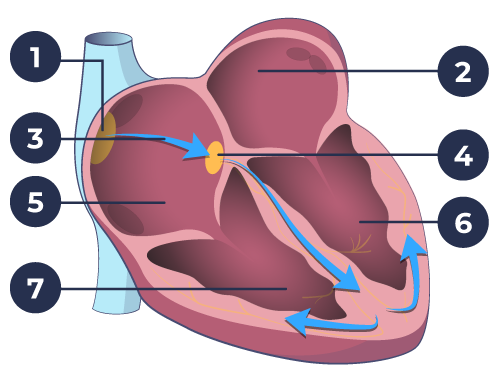The pumping function of your heart is controlled by weak electrical impulses which are formed in an area of the right atrium, which is called the “sinus node”. The sinus node is occasionally called the “natural pacemaker” of your heart. It sends out impulses regularly, called the sinus rhythm. It sends more if you are physically active and fewer if you relax. These impulses propagate in the heart – first through the atria and then through the heart chambers. This first causes the atria to contract and thus empty. And then the heart chambers contract and empty – the “blue and used” blood for the lungs, the “red and fresh oxygenated” blood for the brain, muscles and other organs in the body.
How do the electrical impulses spread?
In the figure below you can see how the impulses usually propagate. They move from the “sinus node” to the “heart chambers” through the AV node. The AV node acts as a kind of relay station, which delays the pulse propagation a little, so that the heart chambers have time to be filled with blood from the atria. When the impulses reach the heart chambers, both the right and left heart chambers contract at the same time and send blood out of the heart to the lungs (right heart chamber) and the rest of the body (left heart chamber), respectively. This is repeated for each and every heartbeat. The heart rests for a brief moment after each heartbeat – then sends a new heartbeat away. In a normal heart, all the chambers thus contract regularly or rhythmically.

- Sinus node
- Left atrium
- Electrical impulses from the sinus node
- AV-node
- Right atrium
- Left ventricle
- Right ventricle
It is your heartbeat that forms your pulse that you can feel – for example at the wrist or on the neck. The speed and regularity of your heart rate – and thus your heart rate – can be measured. The heart rate (beats per minute) tells you how fast your heart is beating. And the rhythm can be judged on whether the pulse is regular (“rhythmic”, “in time”) or whether it is irregular (“irregular”, “out of step”).
When your doctor takes an ECG it is to assess the heart’s electrical impulses. Each part of the ECG reflects different parts of the path of the electrical impulses through the heart.